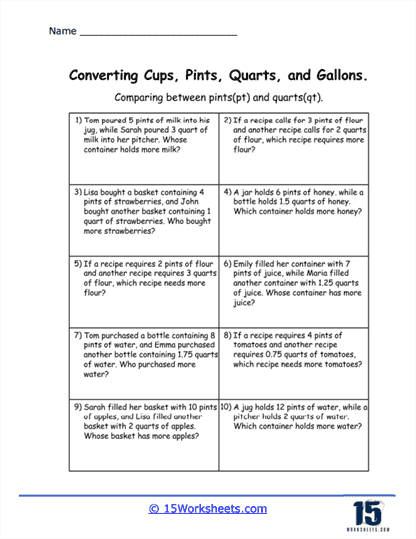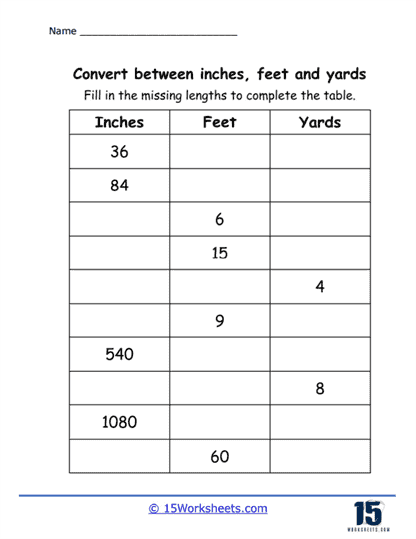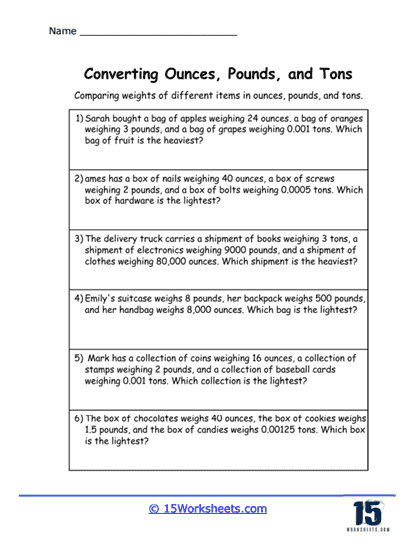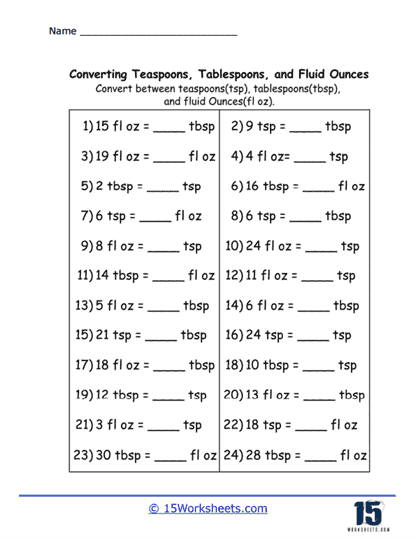U.S. Customary Unit Conversion Worksheets
About These 15 Worksheets
These worksheets will help students learn more about the U.S. customary system of measurement, which is a system of weights and measures derived from the British Imperial System. These worksheets are designed to help students understand and convert between the units used in measuring length, weight, capacity, and temperature. They offer a range of exercises to reinforce learning through practice and application in real-world scenarios.
The U.S. customary system comprises various units for measuring different attributes:
Length: Units include inches, feet, yards, and miles.
Weight: Units include ounces, pounds, and tons.
Capacity: Units include teaspoons, tablespoons, fluid ounces, cups, pints, quarts, and gallons.
Temperature: The unit used is degrees Fahrenheit.
Through these varied exercises, students not only learn the units of measurement but also how to apply them in practical, real-world contexts. As such, these worksheets play a crucial role in math curricula across the United States, preparing students for everyday tasks and future academic challenges in scientific and technical fields.
These worksheets are structured to include multiple types of exercises, each designed to target specific learning outcomes associated with these measurements. Here’s a detailed look at the various exercises you might find on U.S. Customary Measuring Units Worksheets:
Conversion Exercises
Conversion exercises are fundamental components of these worksheets. They require students to convert measurements from one unit to another within the same category. For example, students may convert inches to feet or gallons to quarts. These exercises help students familiarize themselves with the relative values of different units and the process of multiplying or dividing to achieve the correct conversion.
Word problems incorporate measurement units into real-world scenarios, requiring students to apply their knowledge practically. These problems might involve scenarios like calculating the length of a room, the weight of ingredients in a recipe, or the capacity of a container. Solving these problems helps students understand practical applications of measurement and develops their problem-solving skills.
Estimation Exercises
Estimation exercises challenge students to make educated guesses about measurements without actual measuring tools. For example, students might estimate the weight of a textbook or the length of a classroom desk. These exercises are excellent for developing critical thinking and helping students get a practical sense of measurement.
Matching and Sorting Activities
These activities involve matching or sorting different units with their corresponding measurements or objects. For example, students might match various items to their approximate weights or sort a list of measurements in ascending or descending order. These exercises reinforce the relationships between units and their practical implications.
Diagram Labeling
Diagrams on worksheets often depict objects with parts to be measured by the student. Students must use the appropriate U.S. customary unit to label each part of the diagram. This exercise helps enhance spatial awareness and the ability to visualize dimensions. These exercises provide sentences with missing measurement units, where students fill in the blanks with the correct unit based on context. This type of exercise tests the student’s understanding of which units are appropriate for different measurement contexts.
Practical Measurement Tasks
Some worksheets may include instructions for students to measure items around their classroom or home using rulers, weighing scales, or measuring cups. These tasks provide hands-on experience with measuring tools and reinforce the practical use of measurement units. These specific exercises focus on converting temperatures between Fahrenheit and Celsius. They often include practical scenarios like adjusting cooking temperatures or comparing weather conditions in different climates.
What Are U.S. Customary Base Measurement Units?
The U.S. customary system is a collection of measurement units traditionally used in the United States, which is derived from the British Imperial System. This system includes a range of units for measuring length, weight, capacity, and temperature, each with base units from which other units are derived. Understanding these base units is crucial for daily activities, commerce, science, and engineering within the U.S., where these units are predominantly used.
Length
The fundamental base unit of length in the U.S. customary system is the inch. The inch is widely used in various applications, from construction to manufacturing. In practical terms, twelve inches make up a foot, another commonly used unit of length. Feet and inches are used extensively in the United States for measuring the height of individuals, the dimensions of rooms, and the size of objects such as furniture and appliances. Larger measurements, such as those needed for roads and large plots of land, are expressed in yards (three feet) and miles (5280 feet), but these are derivatives of the base unit, the inch.
Weight
For weight, the base unit in the U.S. customary system is the pound. The pound is critical for many sectors including grocery trading, body weight measurement in healthcare, and weights in gyms. Lighter items are often measured in ounces, where sixteen ounces equal one pound. Heavier weights, such as those of vehicles or large animals, are sometimes expressed in tons (2000 pounds). The pound’s widespread use in commerce and daily life makes it indispensable for economic transactions and personal activities.
Capacity
In terms of liquid capacity, the gallon serves as the base unit. The gallon is used primarily for commerce in liquids such as gasoline, milk, and other beverages. Smaller volumes are measured in quarts, pints, and cups-direct derivatives of the gallon. For example, a gallon is equal to four quarts, eight pints, or sixteen cups. These subdivisions make the gallon an extremely versatile unit for a variety of liquid measuring needs, from cooking recipes to fuel purchases.
Temperature
Temperature in the U.S. customary system is measured in degrees Fahrenheit. This is the standard scale used in daily weather forecasts, medical body temperature readings, and cooking. Fahrenheit is a critical measurement for everyday life-ensuring the safety and effectiveness of heating and cooling systems, gauging the proper cooking temperature for foods, and maintaining the appropriate environmental conditions in healthcare settings.
Real-World Applications
In real-world applications, these U.S. customary units are ubiquitous across various sectors. In construction and engineering, feet and inches are essential for designing buildings and creating machinery that fits specific dimensions. In cooking and dieting, ounces and pounds measure portion sizes and food quantities, crucial for recipes and nutritional information.
In the medical field, pounds and Fahrenheit are used to monitor patient health through weight checks and temperature readings, respectively. These measurements are fundamental for diagnosing conditions and prescribing treatments. For transportation and logistics, gallons and miles determine fuel needs and travel distances, directly impacting costs and planning.
In retail, products are often sold by weight in pounds or volume in gallons, affecting pricing, packaging, and shipping. The use of these units in everyday commerce underscores their importance in economic activities and household management.
Are U.S. Customary Units and the Imperial Measurement Systems the Same?
The U.S. Customary Units and the Imperial Measurement Systems are both systems of measurement that have their roots in historical British units of measurement. While they share many similarities in terms of the names and types of units used, there are key differences in the actual sizes of these units and the context of their usage. Understanding these similarities and differences is essential for anyone working with measurements in contexts where both systems might be employed.
Similarities
1. Historical Origins – Both systems originated from the English system of measures, which was in use in the British Empire before the American Revolution. As a result, many of the unit names and types are the same or very similar, such as pints, gallons, miles, yards, and pounds.
2. Types of Measurements – Both systems include units for measuring length (or distance), weight (or mass), and volume. For example, both systems use feet and yards for shorter distances, miles for longer distances, pounds for weight, and gallons for liquid volume.
3. Unit Names – Many of the unit names are exactly the same in both systems. This includes units such as pounds, inches, feet, yards, and miles for length and weight, as well as pints, quarts, and gallons for volumes.
Differences
1. Unit Sizes – Although the names are similar, the sizes of some units differ between the two systems. For instance:
A gallon in the U.S. Customary system is defined as 231 cubic inches, whereas the Imperial gallon is larger, defined as approximately 277.42 cubic inches. This means that the Imperial gallon holds more liquid than the U.S. gallon.
Fluid ounces in the two systems are also different; an Imperial fluid ounce is larger than a U.S. fluid ounce. This results in discrepancies in measurements such as pints and quarts (1 U.S. pint = 16 U.S. fluid ounces, whereas 1 Imperial pint = 20 Imperial fluid ounces).
2. Usage – The U.S. Customary System is primarily used in the United States, while the Imperial System, despite its British origins, is now more commonly used in the United Kingdom, Canada (partially for certain measurements), and some other Commonwealth countries. The U.S. system remains almost exclusively non-metric among the industrialized countries of the world.
3. Thermodynamic Temperature – Temperature in the U.S. Customary system is measured in degrees Fahrenheit, whereas the Imperial system uses both Celsius and Fahrenheit, with a growing preference for Celsius, especially in scientific and most practical applications outside of the U.S.
4. Legal Standards – The definitions of units in the Imperial system have been metricated (i.e., defined relative to metric units) in many places, such as the UK and Canada, as part of the ongoing transition to the metric system. In contrast, the U.S. Customary units are legally defined based on an older system of standards, which can lead to slight variations in unit definitions compared to their Imperial counterparts.
Practical Implications
For individuals working in fields like engineering, cooking, or international trade, these differences can be significant. For example, when manufacturing products for international distribution, the difference in volume measurements can affect everything from fluid capacities in automotive design to ingredient proportions in packaged food products. Additionally, misunderstandings or miscommunications in unit conversion can lead to errors in building specifications, engineering projects, or even medication dosages.




